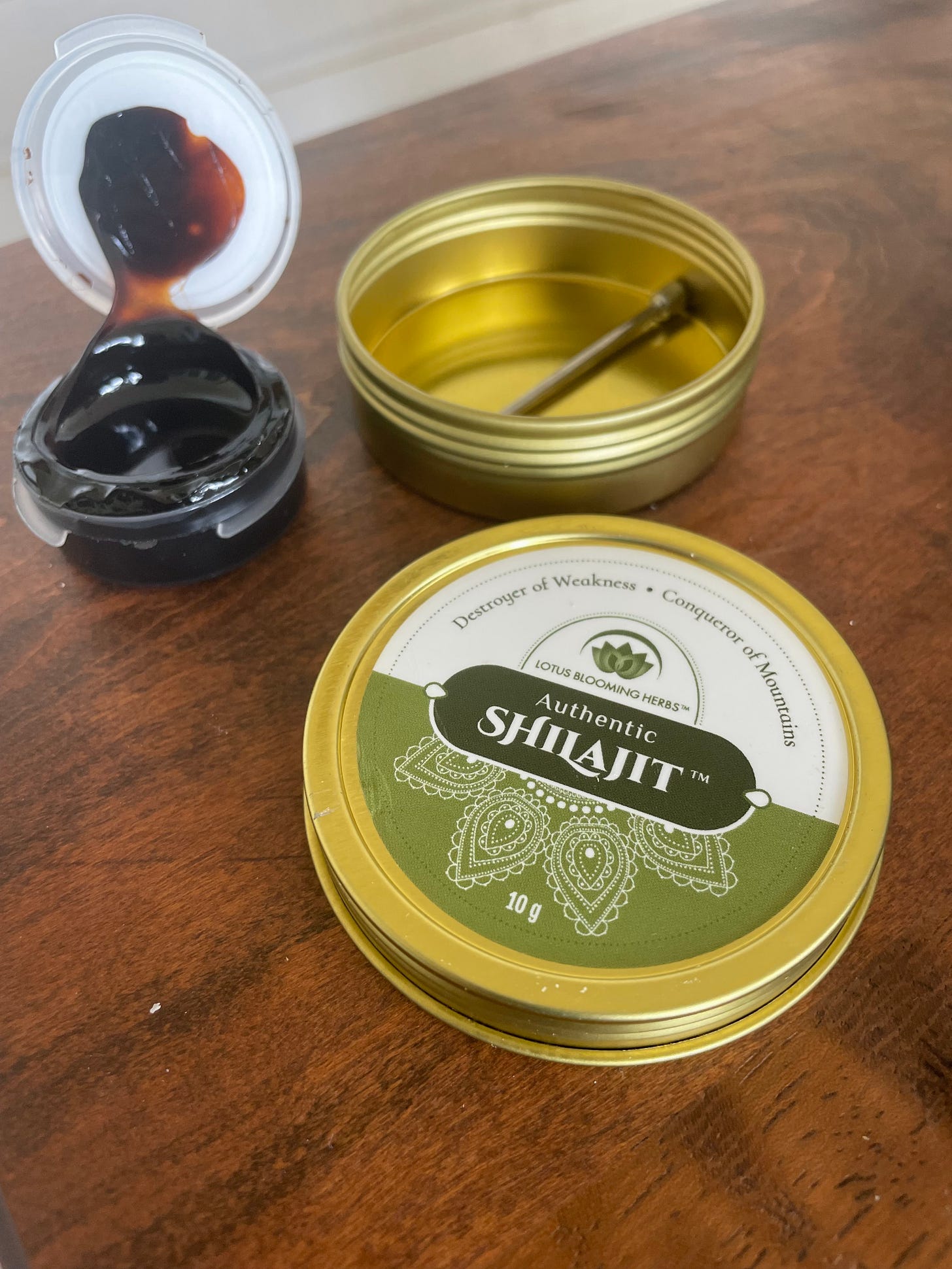Shilajit. What it is and why you may want to take it.
This is not a supplement per se. The brand that I use.
NOTE: My son, who lives in Asia, is coming to the US this week for August. I have not seen him in two and a half years. I have much I want to write and substack about, but it will have to wait.
I will return to providing nutrition and health information after our visit.
What is Shilajit?

Interestingly, both of my sons asked me about Shilajit within hours of each other. I thought they were talking together about it but had not. They wanted to know if I heard of it and what I thought about it.
Shilajit has been touted as useful for restoring energy balance, supporting cognition, slowing aging, and preventing disease. Ayurvedic medicine has known about Shilajit’s rejuvenating and anti-aging properties for centuries.
Shilajit is not a food nor a supplement. It is a compound created over centuries from plants in mountain crevices, mainly in the Himalayas between India and Nepal. Shilajit has also been found in Russia, Tibet, Afghanistan, and the north of Chile.
The black-brown tar-like substance is created via slow decomposition by the action of microorganisms over centuries. In warm weather, the decomposed plant matter will ooze from the mountain crevices, resulting in a bitter, tar-like, sticky substance.
The health benefits of Shilajit may vary based on which mountainous region it was sourced from.
Why does Shilajit potentially have so many benefits?
A review article by Carrasco-Gallardo et al. (2011) indicated that the composition of Shilajit is a phytocomplex that is rich in fulvic acid and other humic substances that account for 60 to 80% of the total nutraceutical compound.
Humic substances in Shilajit include humins, fulvic acids, and humic acids. Shilajit also contains selenium and other minerals and dibenzo-a-pyrones. Dibenzo-a-pyrones acts as a carrier of other substances. Shilajit also contains some fatty acids and polyphenols.
Fulvic acid is soluble in water under different pH conditions. Its low molecular weight makes it well absorbed in the GI tract and eliminated from the body within hours. Fulvic acid can assist with nutrient absorption, which may be the main component that assists with cleansing the body of toxins and heavy metals.
How to consume Shilajit
In traditional cultures in Nepal and the North of India, children eat Shilajit with their morning breakfast and may add it to their milk. Sherpas claim that Shilajit is part of their diet. If you have ever seen a Sherpa climb a mountain with heavy packs on their backs, I wonder if Shilajit gives them the energy to look like mountain goats as they make their way up mountain ranges.
The Shilajit product I have states to take a tiny amount, such as the size of a grain of rice, and add it to fat such as ghee, warm milk, or coconut oil and consume. Right after, drink a small amount of warm water.
What Shilajit has been used for
Jaundice
GI disorders
Enlarged spleen
Epilepsy
Nervous disorders
Chronic bronchitis
Edema
Hemorrhoids
Alzheimer’s disease prevention
Cognition enhancer
Inflammation
Useful when at high altitudes
Boost testosterone levels
Detoxify, strengthen and nourish the body
Maintain strong kidney function
Regulate weight
It may block oxidative stress and DNA damage induced by radiation
However, the science of all of these benefits is lacking.
The Research
A study using 2 g. of Shilajit daily noted that taking it reduced triglycerides by 21%.
Two hundred milligrams of Shilajit for 90 days decreased blood glucose levels by 6.8% in otherwise healthy males. However, another study using 2 grams for 45 days did not impact blood glucose levels.
Two hundred milligrams for 90 days in infertile men was associated with an increase in testosterone by 23.5%.
Five hundred milligrams of Shilajit (the study used PrimaVie Shilajit) per day elicited favorable muscle and connective tissue adaptations in a study with 63 recreationally active men who performed pre and post-tests after 8 weeks of using Shilajit.
I could locate very few studies using Shilajit, and none that used it in its pure form but rather as a supplement. Therefore, do your homework before giving Shilajit a try.
The downside to consuming Shilajit
If you do not get it from a reliable source, it may contain mycotoxins and heavy metals such as lead, mercury, and arsenic. The Lotus Blooming Herb site has a certificate of analysis for testing for lead, arsenic, cadmium, and mercury.
I prefer having it as a whole sticky substance rather than in tablet form, as I think that in this form, the person is hopefully getting everything within the Shilajit rather than extractions from it.
That being said, Bayan Botanicals is a reputable brand that sells Shilajit in a pressed tablet.
Bottom Line
Shilajit is a wonderful example of how a compound containing numerous beneficial ingredients can be more powerful than isolating any one of them. I see many humic and fulvic acid supplements, but if you are looking for their benefits, it may be better to take them in a natural form rather than in isolation.
Do you take Shilajit? If so, please share if or how it has helped you and the brand you use.
Thank you for reading my posts!
Show my posts some love, please!
It is just me writing, reading, researching, and seeing clients!
I do not use mainstream social media, so please share my posts so that more people can get informed on how to get and stay healthy.
This is NOT information allopathic practitioners will share with you.
Paid subscribers get supplement discounts at my Fullscript online apothecary (if they reside in the US) and consult discounts.
Trufoods Newsletter is a reader-supported publication. To receive new posts and support my work, consider becoming a free or paid subscriber.




You do it Mikey and let us know how it turns out.